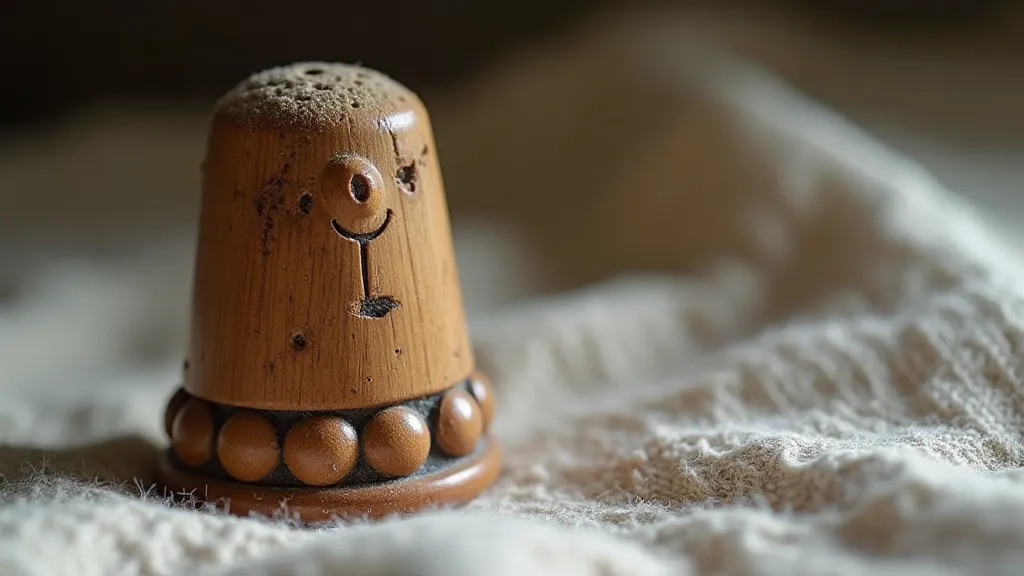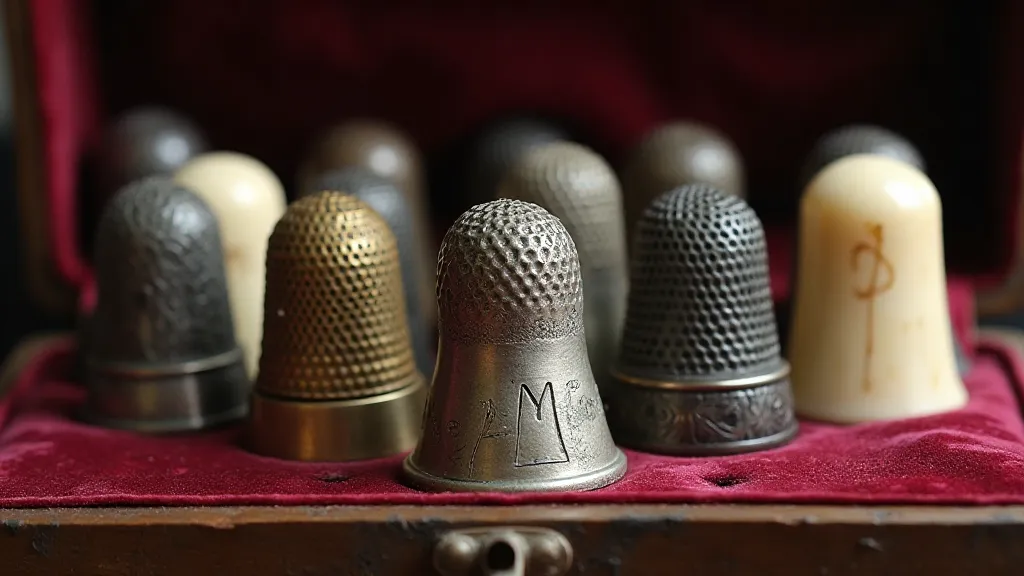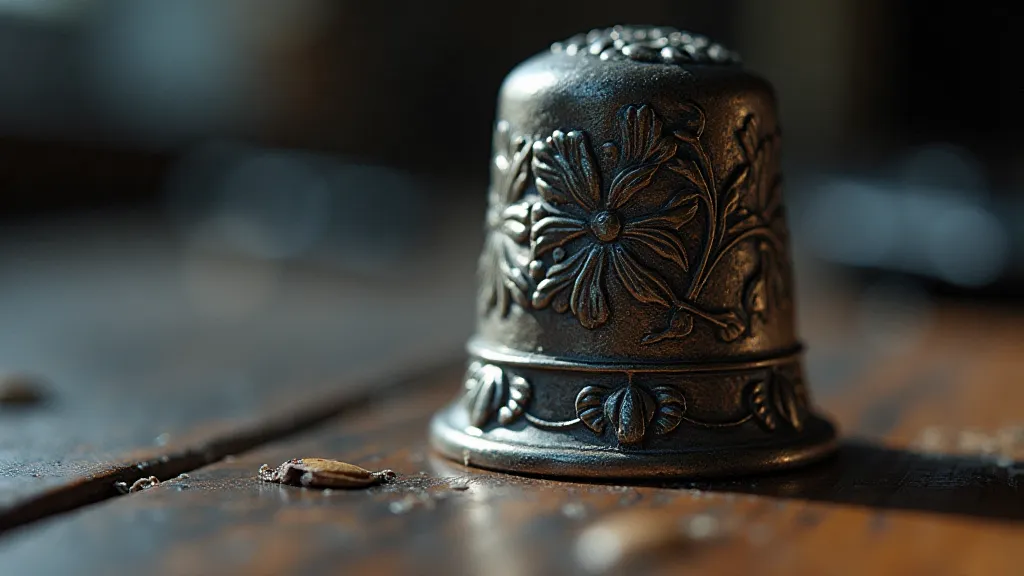Silent Witnesses: Thimbles as Relics of Lost Domestic Industries
Hold one in your hand. Really *hold* it. Feel the cool weight, the minute imperfections, the ghost of countless stitches pressed into its surface. An antique thimble is more than just a small, utilitarian object; it’s a silent witness to a vanished world—a world where homes were workshops, and the rhythm of domestic industry echoed through every room. We collect them, catalog them, admire their beauty, but do we truly understand what they *represent*? These diminutive artifacts are poignant reminders of a time when skilled hands, not automated machinery, crafted the textiles that clothed families and adorned homes.
My grandmother, Elsie, was a master seamstress. I remember sitting at her feet as a child, mesmerized by the whirring of her Singer sewing machine and the precise, graceful movements of her hands guiding fabric beneath the needle. She always wore a thimble – a simple, silver one, dented with years of use. It wasn’t a decorative piece; it was a tool, an extension of her hand, a vital partner in her daily craft. When she passed, that thimble became a treasured keepsake, a tangible connection to her memory, to the comfort and beauty she brought into our lives, and to the vanishing skill of a generation. The intangible value of heirloom thimbles, and objects like them, are often overlooked, representing far more than their material worth.
The Rise of the Home Workshop
For centuries, sewing and textile production were cornerstones of the domestic economy. Before the Industrial Revolution, most clothing was made at home. Women (and sometimes men) were expected to be skilled in needlework, capable of mending, altering, and creating garments for their families. The thimble was, quite literally, indispensable. It wasn’t a luxury; it was a necessity, a protector of fingertips working tirelessly to turn raw materials into wearable goods. Wealthier families might own intricately carved ivory or silver thimbles, while poorer families would make do with simpler, often homemade versions of wood or horn. These variations reflect the socioeconomic landscape of the time; the thimble itself became a subtle marker of status, but always linked to the essential act of creation.

The rise of the thimble itself mirrors this shift. Early thimbles were often made from whatever was readily available – berries, seeds, nutshells. As craft skills developed, they were fashioned from leather, horn, and eventually, metal. The Victorian era saw an explosion of thimble production, fueled by the demand from a burgeoning middle class who could now afford more elaborate sewing equipment and accessories. This period also witnessed a brief but passionate craze for novelty thimbles, decorated with intricate scenes, portraits, and even miniature buildings. The way collections evolved, transitioning from parlor displays to more personal, portable items, reflects changing social customs – a fascinating look at from parlor to pocket.
The Shadow of Mass Production
The Industrial Revolution dramatically altered the landscape of textile production. Factories sprung up, equipped with power looms and sewing machines, capable of producing vast quantities of cloth and garments at unprecedented speed. The home workshop began to fade. Suddenly, there was less *need* for families to make their own clothes. While sewing skills didn't disappear entirely, their importance diminished significantly. The once-essential thimble became, for many, a relic of a bygone era.
The transition wasn't immediate or painless. For many women, the loss of home-based income was devastating, and the allure of factory work, while often exploitative, offered a fragile lifeline. The thimble, once a symbol of self-sufficiency and domestic pride, quietly became a reminder of what had been lost. Imagine the countless hands that once held these tiny protectors, now working in the anonymity of a factory, their skills devalued, their independence diminished. The silence of the antique thimble speaks volumes about this displacement. The stories embedded in these seemingly simple objects, the echoes of forgotten hands, are what truly captivate collectors – a narrative explored further in echoes in silver.
A Spectrum of Materials and Craftsmanship
The beauty of collecting antique thimbles lies not just in their aesthetic appeal, but also in the stories they tell about the materials used and the techniques employed. Silver thimbles, often hallmarked, represent a level of investment and luxury. Brass and pewter thimbles offer a more accessible elegance. Bone and ivory thimbles reveal a connection to natural resources and intricate carving skills. Many were hand-engraved with intricate designs – floral motifs, heraldic symbols, or personalized initials. These weren't mere decorations; they were declarations of identity, testaments to the craftsman's artistry.

The “wearing pattern” – the areas of greatest wear and tear – can also reveal fascinating insights. Heavily worn edges suggest extensive use, while pristine surfaces might indicate a thimble that was treasured but rarely employed. Even the tiny dents and scratches tell a story of countless stitches, of projects completed and garments created. It’s like reading a topographical map of a hand’s work. The legacy of these objects goes beyond the physical; they represent a cultural heritage that deserves recognition and understanding – the inherent intangible value is immense.
Preserving the Legacy – Caring for Your Treasures
If you’re fortunate enough to own antique thimbles, proper care is essential to preserve their legacy. Avoid harsh chemicals and abrasive cleaners. Gentle polishing with a soft cloth can help remove surface tarnish. For silver thimbles, a specialized silver polish can restore their shine. Storage is equally important; individual pouches or boxes prevent scratching and oxidation. Consider their provenance - do you know the history of the thimble? Sharing this story enhances its value, not just monetarily, but emotionally as well.
The materials used in thimble construction often tell a story of ingenuity and resourcefulness. Early settlers, for example, frequently crafted thimbles from readily available materials such as berries, seeds, and nutshells. As crafts evolved, leather, horn, and metal became increasingly common, reflecting technological advancements and changing economic conditions. The emergence of elaborate designs, such as hand-engraved floral motifs and personalized initials, indicated a shift towards greater ornamentation and a desire to showcase individual identity and artistry.
Examining the "wearing pattern" on a thimble offers a unique window into the life of its user. The areas of greatest wear and tear reveal the types of projects undertaken and the intensity of use. A heavily worn edge suggests frequent use for intricate stitching, while a pristine surface may indicate a treasured heirloom rarely employed. Even the smallest dents and scratches contribute to the overall story, providing glimpses into the countless stitches and garments created.
The evolution of thimble design is closely tied to broader social and economic trends. The Victorian era witnessed a proliferation of novelty thimbles adorned with intricate scenes and portraits, reflecting the burgeoning middle class's desire for luxury goods and personalized accessories. The Industrial Revolution spurred the mass production of simpler, more utilitarian thimbles, catering to the needs of factory workers and garment manufacturers.

Beyond their aesthetic appeal and historical significance, antique thimbles possess a unique ability to evoke a sense of connection to the past. Holding one in your hand, you can almost feel the presence of the skilled hands that once guided the needle, the countless hours of labor invested in creating garments for families and communities. These small objects serve as tangible reminders of a time when craftsmanship and domestic industry were integral parts of everyday life.
For those with a passion for collecting antique thimbles, proper care and preservation are paramount to ensuring that these precious artifacts endure for generations to come. Gentle cleaning with soft cloths, specialized silver polish for silver thimbles, and careful storage in individual pouches or boxes are essential practices. Sharing the provenance and history of a thimble not only enhances its value but also deepens the emotional connection to this piece of history.
More than just collectibles, antique thimbles are tangible links to a past where craftsmanship and domestic industry intertwined. They remind us of the skill, ingenuity, and dedication of generations of women (and men) who labored to provide for their families. Each one whispers a silent story of a world transformed, a world where the rhythm of the needle and thread once echoed throughout the home. Hold one in your hand again. Consider the lives it touched, the garments it protected. It’s a small object, but it holds a universe of history within its tiny form.





